Abdallah Khreishah
ViGText: Deepfake Image Detection with Vision-Language Model Explanations and Graph Neural Networks
Jul 24, 2025Abstract:The rapid rise of deepfake technology, which produces realistic but fraudulent digital content, threatens the authenticity of media. Traditional deepfake detection approaches often struggle with sophisticated, customized deepfakes, especially in terms of generalization and robustness against malicious attacks. This paper introduces ViGText, a novel approach that integrates images with Vision Large Language Model (VLLM) Text explanations within a Graph-based framework to improve deepfake detection. The novelty of ViGText lies in its integration of detailed explanations with visual data, as it provides a more context-aware analysis than captions, which often lack specificity and fail to reveal subtle inconsistencies. ViGText systematically divides images into patches, constructs image and text graphs, and integrates them for analysis using Graph Neural Networks (GNNs) to identify deepfakes. Through the use of multi-level feature extraction across spatial and frequency domains, ViGText captures details that enhance its robustness and accuracy to detect sophisticated deepfakes. Extensive experiments demonstrate that ViGText significantly enhances generalization and achieves a notable performance boost when it detects user-customized deepfakes. Specifically, average F1 scores rise from 72.45% to 98.32% under generalization evaluation, and reflects the model's superior ability to generalize to unseen, fine-tuned variations of stable diffusion models. As for robustness, ViGText achieves an increase of 11.1% in recall compared to other deepfake detection approaches. When facing targeted attacks that exploit its graph-based architecture, ViGText limits classification performance degradation to less than 4%. ViGText uses detailed visual and textual analysis to set a new standard for detecting deepfakes, helping ensure media authenticity and information integrity.
SoK: Are Watermarks in LLMs Ready for Deployment?
Jun 05, 2025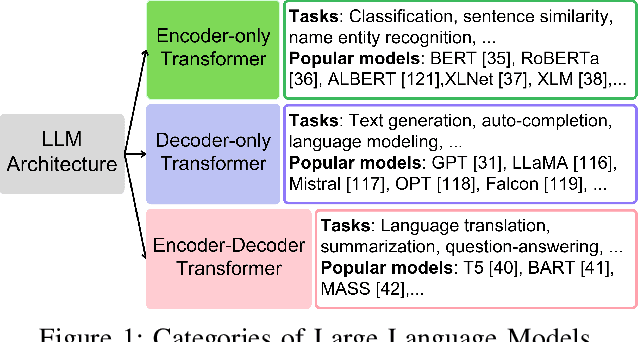
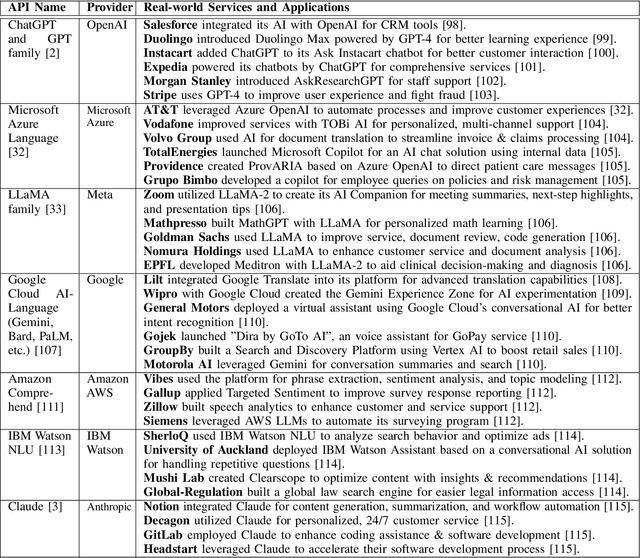
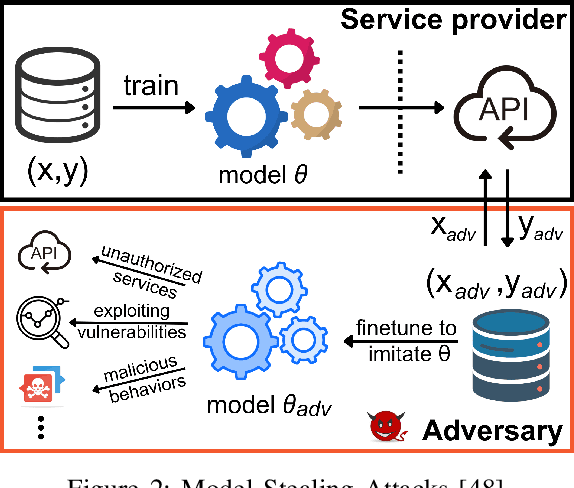
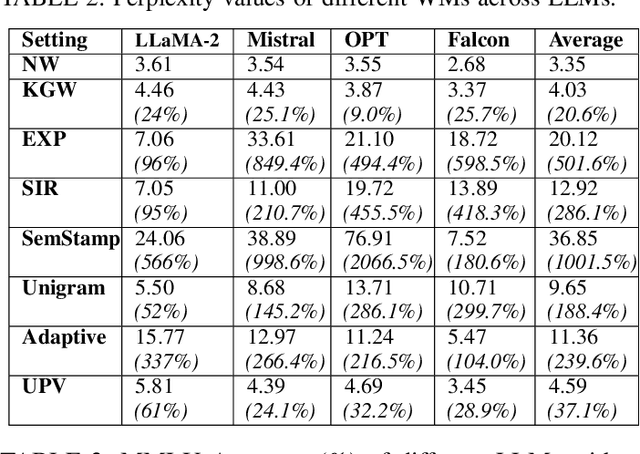
Abstract:Large Language Models (LLMs) have transformed natural language processing, demonstrating impressive capabilities across diverse tasks. However, deploying these models introduces critical risks related to intellectual property violations and potential misuse, particularly as adversaries can imitate these models to steal services or generate misleading outputs. We specifically focus on model stealing attacks, as they are highly relevant to proprietary LLMs and pose a serious threat to their security, revenue, and ethical deployment. While various watermarking techniques have emerged to mitigate these risks, it remains unclear how far the community and industry have progressed in developing and deploying watermarks in LLMs. To bridge this gap, we aim to develop a comprehensive systematization for watermarks in LLMs by 1) presenting a detailed taxonomy for watermarks in LLMs, 2) proposing a novel intellectual property classifier to explore the effectiveness and impacts of watermarks on LLMs under both attack and attack-free environments, 3) analyzing the limitations of existing watermarks in LLMs, and 4) discussing practical challenges and potential future directions for watermarks in LLMs. Through extensive experiments, we show that despite promising research outcomes and significant attention from leading companies and community to deploy watermarks, these techniques have yet to reach their full potential in real-world applications due to their unfavorable impacts on model utility of LLMs and downstream tasks. Our findings provide an insightful understanding of watermarks in LLMs, highlighting the need for practical watermarks solutions tailored to LLM deployment.
A Client-level Assessment of Collaborative Backdoor Poisoning in Non-IID Federated Learning
Apr 21, 2025Abstract:Federated learning (FL) enables collaborative model training using decentralized private data from multiple clients. While FL has shown robustness against poisoning attacks with basic defenses, our research reveals new vulnerabilities stemming from non-independent and identically distributed (non-IID) data among clients. These vulnerabilities pose a substantial risk of model poisoning in real-world FL scenarios. To demonstrate such vulnerabilities, we develop a novel collaborative backdoor poisoning attack called CollaPois. In this attack, we distribute a single pre-trained model infected with a Trojan to a group of compromised clients. These clients then work together to produce malicious gradients, causing the FL model to consistently converge towards a low-loss region centered around the Trojan-infected model. Consequently, the impact of the Trojan is amplified, especially when the benign clients have diverse local data distributions and scattered local gradients. CollaPois stands out by achieving its goals while involving only a limited number of compromised clients, setting it apart from existing attacks. Also, CollaPois effectively avoids noticeable shifts or degradation in the FL model's performance on legitimate data samples, allowing it to operate stealthily and evade detection by advanced robust FL algorithms. Thorough theoretical analysis and experiments conducted on various benchmark datasets demonstrate the superiority of CollaPois compared to state-of-the-art backdoor attacks. Notably, CollaPois bypasses existing backdoor defenses, especially in scenarios where clients possess diverse data distributions. Moreover, the results show that CollaPois remains effective even when involving a small number of compromised clients. Notably, clients whose local data is closely aligned with compromised clients experience higher risks of backdoor infections.
Demo: SGCode: A Flexible Prompt-Optimizing System for Secure Generation of Code
Sep 11, 2024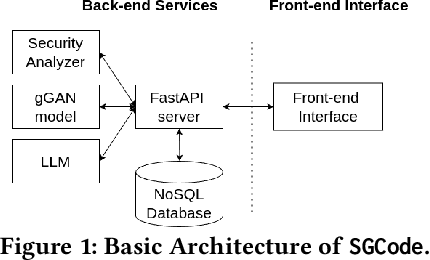

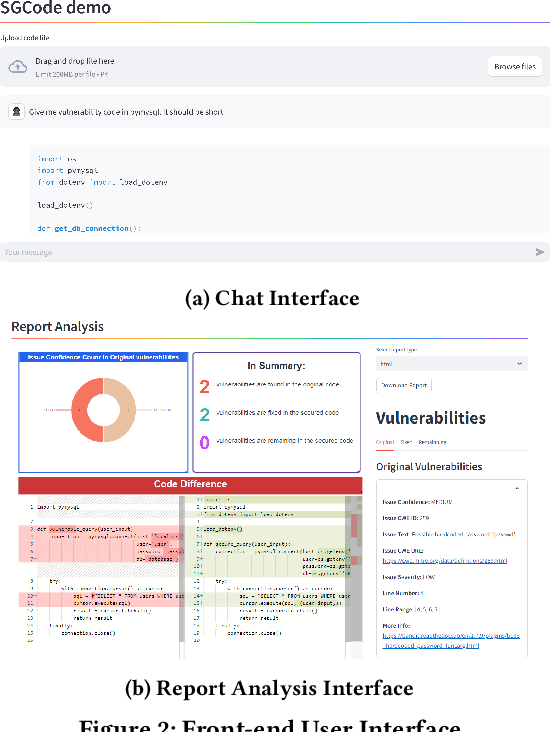
Abstract:This paper introduces SGCode, a flexible prompt-optimizing system to generate secure code with large language models (LLMs). SGCode integrates recent prompt-optimization approaches with LLMs in a unified system accessible through front-end and back-end APIs, enabling users to 1) generate secure code, which is free of vulnerabilities, 2) review and share security analysis, and 3) easily switch from one prompt optimization approach to another, while providing insights on model and system performance. We populated SGCode on an AWS server with PromSec, an approach that optimizes prompts by combining an LLM and security tools with a lightweight generative adversarial graph neural network to detect and fix security vulnerabilities in the generated code. Extensive experiments show that SGCode is practical as a public tool to gain insights into the trade-offs between model utility, secure code generation, and system cost. SGCode has only a marginal cost compared with prompting LLMs. SGCode is available at: http://3.131.141.63:8501/.
Genetic Algorithm-Based Dynamic Backdoor Attack on Federated Learning-Based Network Traffic Classification
Sep 27, 2023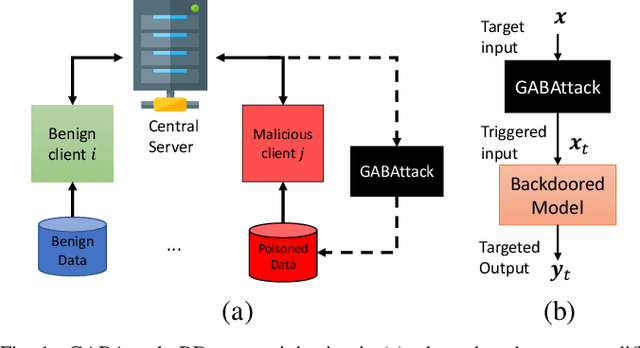

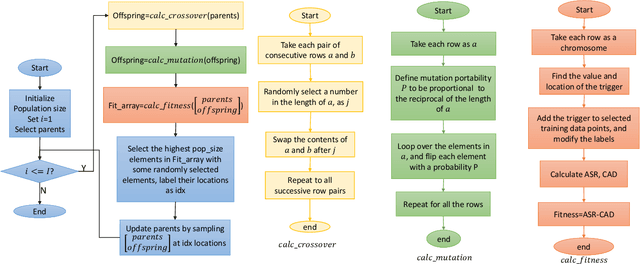
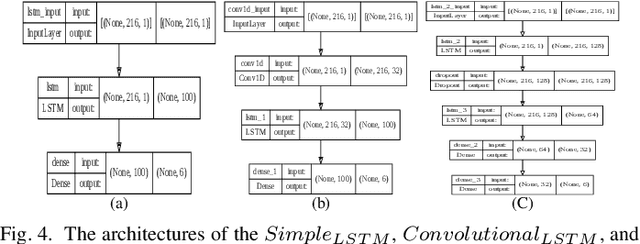
Abstract:Federated learning enables multiple clients to collaboratively contribute to the learning of a global model orchestrated by a central server. This learning scheme promotes clients' data privacy and requires reduced communication overheads. In an application like network traffic classification, this helps hide the network vulnerabilities and weakness points. However, federated learning is susceptible to backdoor attacks, in which adversaries inject manipulated model updates into the global model. These updates inject a salient functionality in the global model that can be launched with specific input patterns. Nonetheless, the vulnerability of network traffic classification models based on federated learning to these attacks remains unexplored. In this paper, we propose GABAttack, a novel genetic algorithm-based backdoor attack against federated learning for network traffic classification. GABAttack utilizes a genetic algorithm to optimize the values and locations of backdoor trigger patterns, ensuring a better fit with the input and the model. This input-tailored dynamic attack is promising for improved attack evasiveness while being effective. Extensive experiments conducted over real-world network datasets validate the success of the proposed GABAttack in various situations while maintaining almost invisible activity. This research serves as an alarming call for network security experts and practitioners to develop robust defense measures against such attacks.
Multi-Instance Adversarial Attack on GNN-Based Malicious Domain Detection
Aug 22, 2023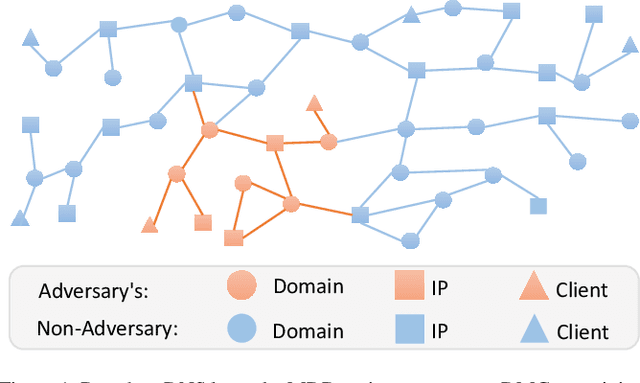

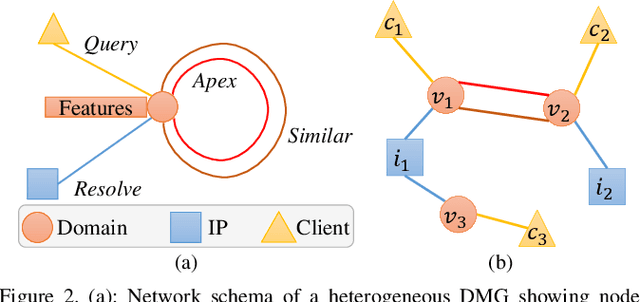

Abstract:Malicious domain detection (MDD) is an open security challenge that aims to detect if an Internet domain is associated with cyber-attacks. Among many approaches to this problem, graph neural networks (GNNs) are deemed highly effective. GNN-based MDD uses DNS logs to represent Internet domains as nodes in a maliciousness graph (DMG) and trains a GNN to infer their maliciousness by leveraging identified malicious domains. Since this method relies on accessible DNS logs to construct DMGs, it exposes a vulnerability for adversaries to manipulate their domain nodes' features and connections within DMGs. Existing research mainly concentrates on threat models that manipulate individual attacker nodes. However, adversaries commonly generate multiple domains to achieve their goals economically and avoid detection. Their objective is to evade discovery across as many domains as feasible. In this work, we call the attack that manipulates several nodes in the DMG concurrently a multi-instance evasion attack. We present theoretical and empirical evidence that the existing single-instance evasion techniques for are inadequate to launch multi-instance evasion attacks against GNN-based MDDs. Therefore, we introduce MintA, an inference-time multi-instance adversarial attack on GNN-based MDDs. MintA enhances node and neighborhood evasiveness through optimized perturbations and operates successfully with only black-box access to the target model, eliminating the need for knowledge about the model's specifics or non-adversary nodes. We formulate an optimization challenge for MintA, achieving an approximate solution. Evaluating MintA on a leading GNN-based MDD technique with real-world data showcases an attack success rate exceeding 80%. These findings act as a warning for security experts, underscoring GNN-based MDDs' susceptibility to practical attacks that can undermine their effectiveness and benefits.
Semi-decentralized Inference in Heterogeneous Graph Neural Networks for Traffic Demand Forecasting: An Edge-Computing Approach
Feb 28, 2023Abstract:Accurate and timely prediction of transportation demand and supply is essential for improving customer experience and raising the provider's profit. Recently, graph neural networks (GNNs) have been shown promising in predicting traffic demand and supply in small city regions. This awes their capability in modeling both a node's historical features and its relational information with other nodes. However, more efficient taxi demand and supply forecasting can still be achieved by following two main routes. First, is extending the scale of the prediction graph to include more regions. Second, is the simultaneous exploitation of multiple node and edge types to better expose and exploit the complex and diverse set of relations in a traffic system. Nevertheless, the applicability of both approaches is challenged by the scalability of system-wide GNN training and inference. An immediate remedy to the scalability challenge is to decentralize the GNN operation. However, decentralizing GNN operation creates excessive node-to-node communication overhead which hinders the potential of this approach. In this paper, we propose a semi-decentralized approach based on the use of multiple, moderately sized, and high-throughout cloudlet communication networks on the edge. This approach combines the best features of the centralized and decentralized settings; it may minimize the inter-cloudlet communication thereby alleviating the communication overhead of the decentralized approach while promoting scalability due to cloudlet-level decentralization. Also, we propose a heterogeneous GNN-LSTM algorithm for improved taxi-level demand and supply forecasting. This approach allows for handling dynamic taxi graphs where nodes are taxis. Through a set of experiments over real data, we show the advantage of the semi-decentralized approach as tested over our GNN-LSTM algorithm for taxi demand and supply prediction.
Heterogeneous Randomized Response for Differential Privacy in Graph Neural Networks
Nov 10, 2022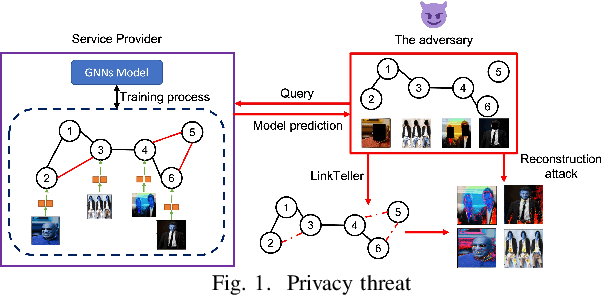

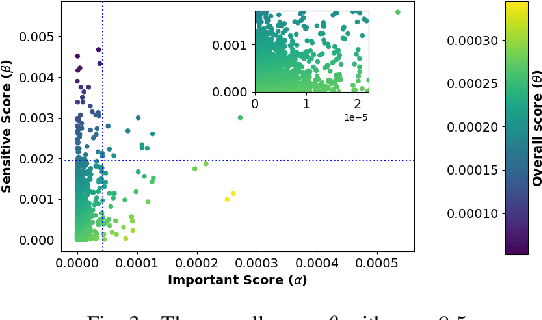
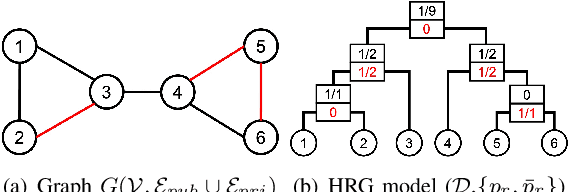
Abstract:Graph neural networks (GNNs) are susceptible to privacy inference attacks (PIAs), given their ability to learn joint representation from features and edges among nodes in graph data. To prevent privacy leakages in GNNs, we propose a novel heterogeneous randomized response (HeteroRR) mechanism to protect nodes' features and edges against PIAs under differential privacy (DP) guarantees without an undue cost of data and model utility in training GNNs. Our idea is to balance the importance and sensitivity of nodes' features and edges in redistributing the privacy budgets since some features and edges are more sensitive or important to the model utility than others. As a result, we derive significantly better randomization probabilities and tighter error bounds at both levels of nodes' features and edges departing from existing approaches, thus enabling us to maintain high data utility for training GNNs. An extensive theoretical and empirical analysis using benchmark datasets shows that HeteroRR significantly outperforms various baselines in terms of model utility under rigorous privacy protection for both nodes' features and edges. That enables us to defend PIAs in DP-preserving GNNs effectively.
An Adaptive Black-box Defense against Trojan Attacks
Sep 05, 2022
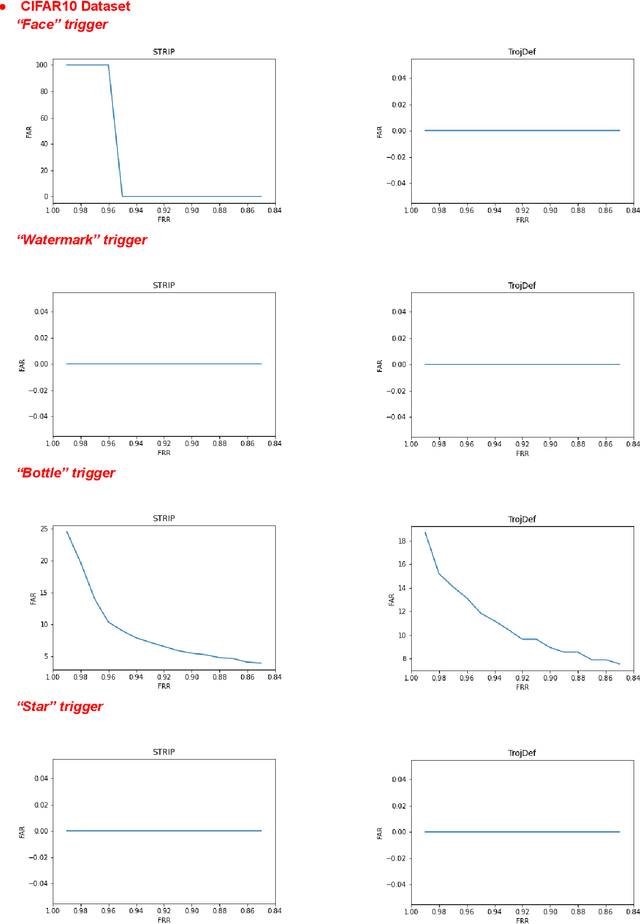
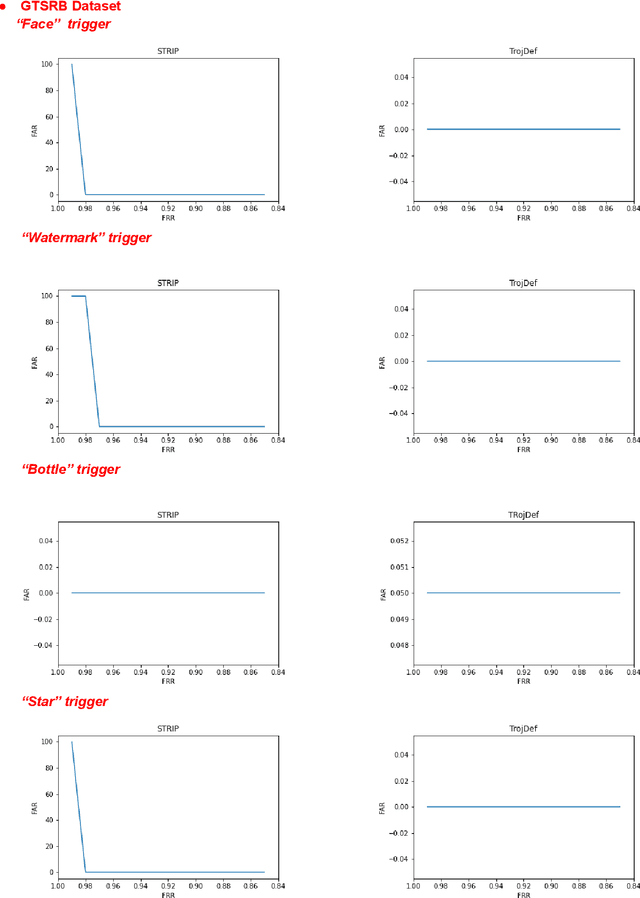
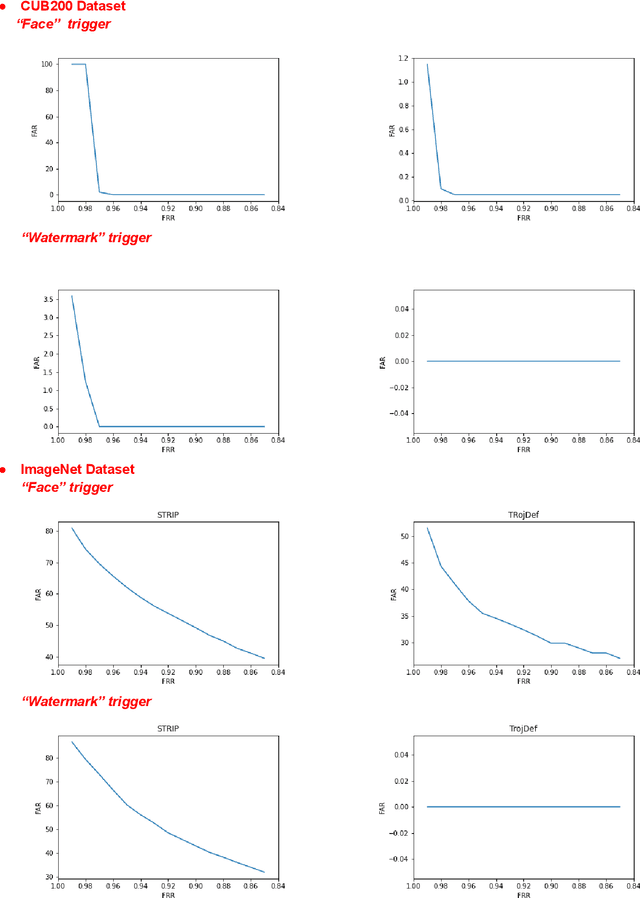
Abstract:Trojan backdoor is a poisoning attack against Neural Network (NN) classifiers in which adversaries try to exploit the (highly desirable) model reuse property to implant Trojans into model parameters for backdoor breaches through a poisoned training process. Most of the proposed defenses against Trojan attacks assume a white-box setup, in which the defender either has access to the inner state of NN or is able to run back-propagation through it. In this work, we propose a more practical black-box defense, dubbed TrojDef, which can only run forward-pass of the NN. TrojDef tries to identify and filter out Trojan inputs (i.e., inputs augmented with the Trojan trigger) by monitoring the changes in the prediction confidence when the input is repeatedly perturbed by random noise. We derive a function based on the prediction outputs which is called the prediction confidence bound to decide whether the input example is Trojan or not. The intuition is that Trojan inputs are more stable as the misclassification only depends on the trigger, while benign inputs will suffer when augmented with noise due to the perturbation of the classification features. Through mathematical analysis, we show that if the attacker is perfect in injecting the backdoor, the Trojan infected model will be trained to learn the appropriate prediction confidence bound, which is used to distinguish Trojan and benign inputs under arbitrary perturbations. However, because the attacker might not be perfect in injecting the backdoor, we introduce a nonlinear transform to the prediction confidence bound to improve the detection accuracy in practical settings. Extensive empirical evaluations show that TrojDef significantly outperforms the-state-of-the-art defenses and is highly stable under different settings, even when the classifier architecture, the training process, or the hyper-parameters change.
Model Transferring Attacks to Backdoor HyperNetwork in Personalized Federated Learning
Jan 19, 2022



Abstract:This paper explores previously unknown backdoor risks in HyperNet-based personalized federated learning (HyperNetFL) through poisoning attacks. Based upon that, we propose a novel model transferring attack (called HNTROJ), i.e., the first of its kind, to transfer a local backdoor infected model to all legitimate and personalized local models, which are generated by the HyperNetFL model, through consistent and effective malicious local gradients computed across all compromised clients in the whole training process. As a result, HNTROJ reduces the number of compromised clients needed to successfully launch the attack without any observable signs of sudden shifts or degradation regarding model utility on legitimate data samples making our attack stealthy. To defend against HNTROJ, we adapted several backdoor-resistant FL training algorithms into HyperNetFL. An extensive experiment that is carried out using several benchmark datasets shows that HNTROJ significantly outperforms data poisoning and model replacement attacks and bypasses robust training algorithms.
 Add to Chrome
Add to Chrome Add to Firefox
Add to Firefox Add to Edge
Add to Edge